Heroin and Impact on the Brain and Behavior
VerifiedAdded on 2023/04/06
|10
|2529
|451
AI Summary
This essay analyzes the impact of heroin on the brain and behavior, including short-term effects, mechanism of action, and long-term changes in brain structure and function.
Contribute Materials
Your contribution can guide someone’s learning journey. Share your
documents today.
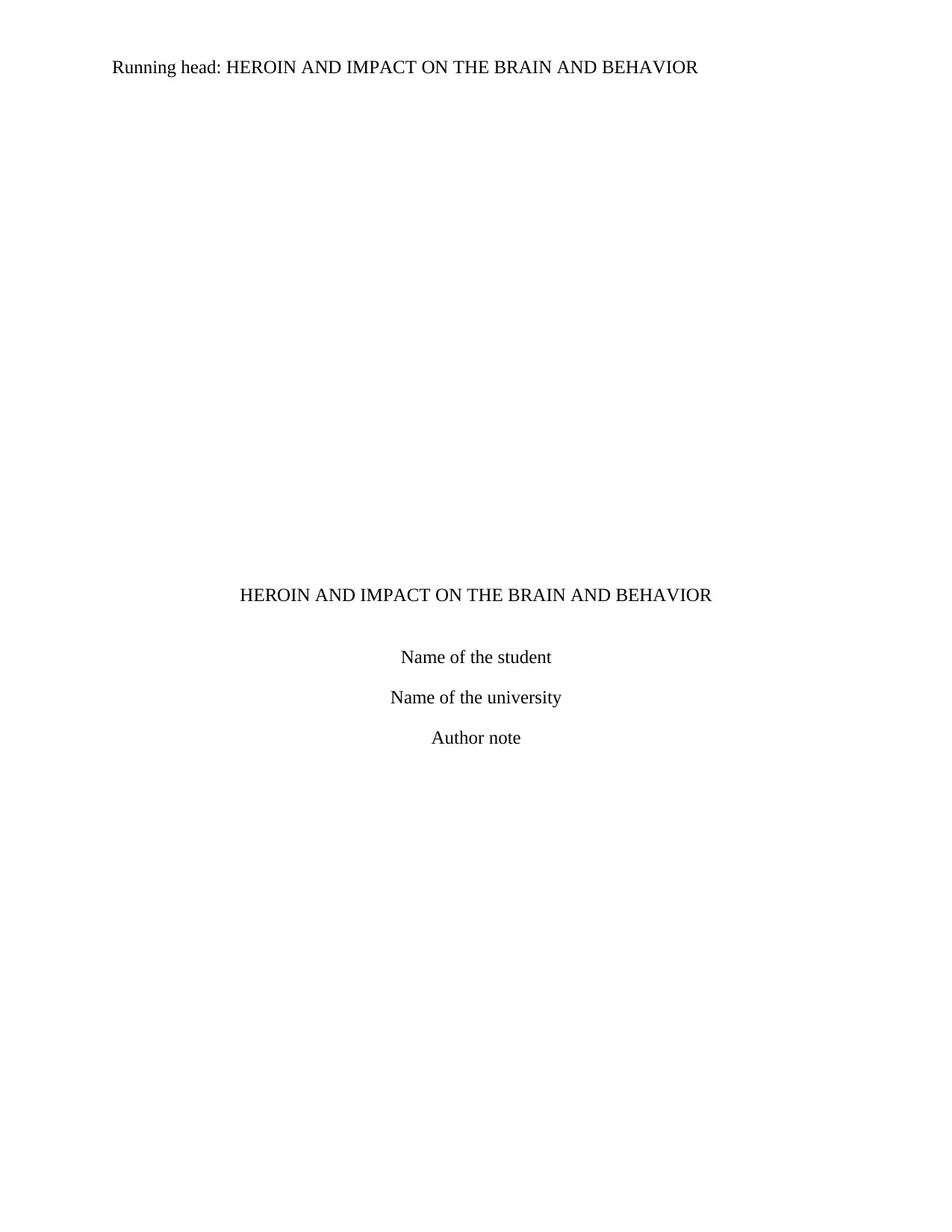
Running head: HEROIN AND IMPACT ON THE BRAIN AND BEHAVIOR
HEROIN AND IMPACT ON THE BRAIN AND BEHAVIOR
Name of the student
Name of the university
Author note
HEROIN AND IMPACT ON THE BRAIN AND BEHAVIOR
Name of the student
Name of the university
Author note
Secure Best Marks with AI Grader
Need help grading? Try our AI Grader for instant feedback on your assignments.
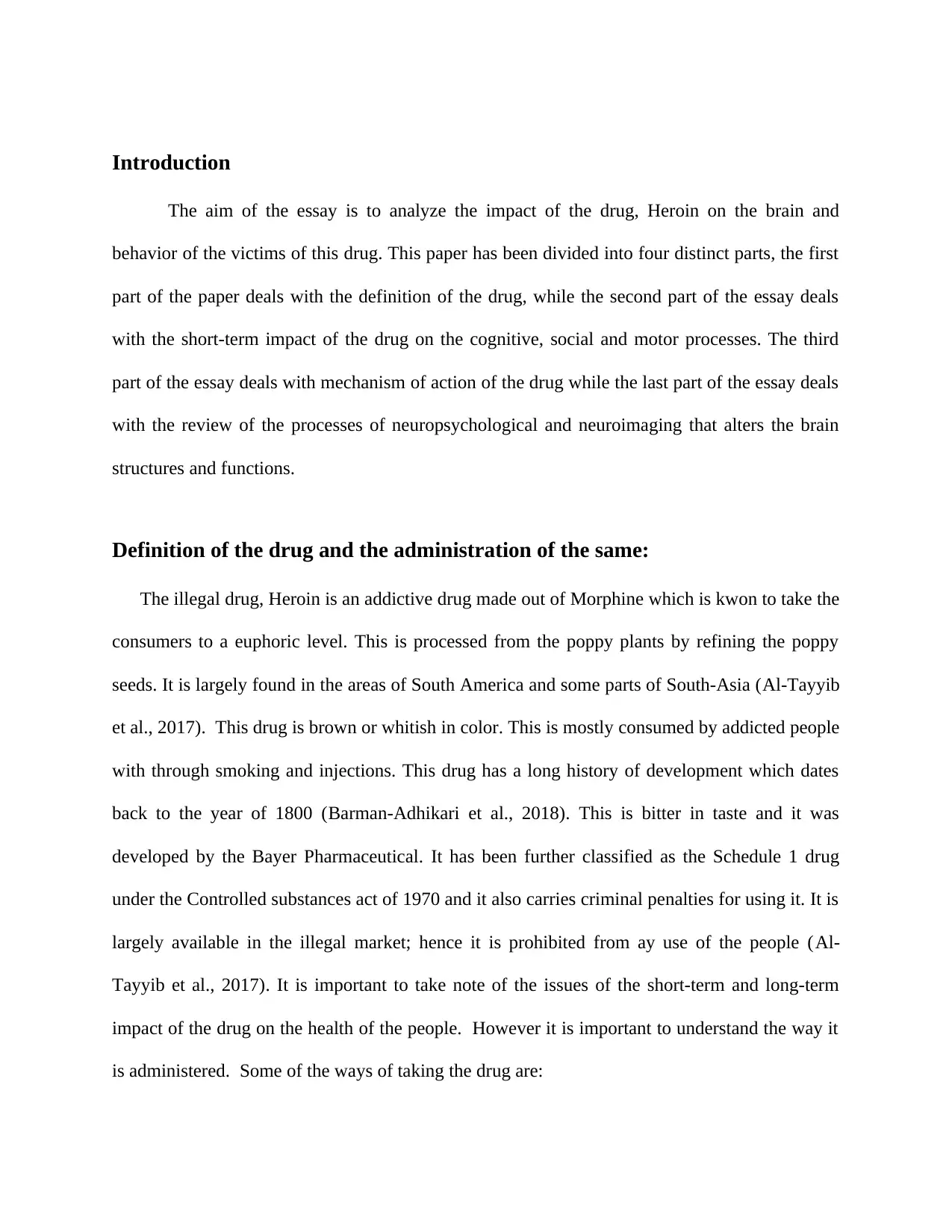
Introduction
The aim of the essay is to analyze the impact of the drug, Heroin on the brain and
behavior of the victims of this drug. This paper has been divided into four distinct parts, the first
part of the paper deals with the definition of the drug, while the second part of the essay deals
with the short-term impact of the drug on the cognitive, social and motor processes. The third
part of the essay deals with mechanism of action of the drug while the last part of the essay deals
with the review of the processes of neuropsychological and neuroimaging that alters the brain
structures and functions.
Definition of the drug and the administration of the same:
The illegal drug, Heroin is an addictive drug made out of Morphine which is kwon to take the
consumers to a euphoric level. This is processed from the poppy plants by refining the poppy
seeds. It is largely found in the areas of South America and some parts of South-Asia (Al-Tayyib
et al., 2017). This drug is brown or whitish in color. This is mostly consumed by addicted people
with through smoking and injections. This drug has a long history of development which dates
back to the year of 1800 (Barman-Adhikari et al., 2018). This is bitter in taste and it was
developed by the Bayer Pharmaceutical. It has been further classified as the Schedule 1 drug
under the Controlled substances act of 1970 and it also carries criminal penalties for using it. It is
largely available in the illegal market; hence it is prohibited from ay use of the people (Al-
Tayyib et al., 2017). It is important to take note of the issues of the short-term and long-term
impact of the drug on the health of the people. However it is important to understand the way it
is administered. Some of the ways of taking the drug are:
The aim of the essay is to analyze the impact of the drug, Heroin on the brain and
behavior of the victims of this drug. This paper has been divided into four distinct parts, the first
part of the paper deals with the definition of the drug, while the second part of the essay deals
with the short-term impact of the drug on the cognitive, social and motor processes. The third
part of the essay deals with mechanism of action of the drug while the last part of the essay deals
with the review of the processes of neuropsychological and neuroimaging that alters the brain
structures and functions.
Definition of the drug and the administration of the same:
The illegal drug, Heroin is an addictive drug made out of Morphine which is kwon to take the
consumers to a euphoric level. This is processed from the poppy plants by refining the poppy
seeds. It is largely found in the areas of South America and some parts of South-Asia (Al-Tayyib
et al., 2017). This drug is brown or whitish in color. This is mostly consumed by addicted people
with through smoking and injections. This drug has a long history of development which dates
back to the year of 1800 (Barman-Adhikari et al., 2018). This is bitter in taste and it was
developed by the Bayer Pharmaceutical. It has been further classified as the Schedule 1 drug
under the Controlled substances act of 1970 and it also carries criminal penalties for using it. It is
largely available in the illegal market; hence it is prohibited from ay use of the people (Al-
Tayyib et al., 2017). It is important to take note of the issues of the short-term and long-term
impact of the drug on the health of the people. However it is important to understand the way it
is administered. Some of the ways of taking the drug are:
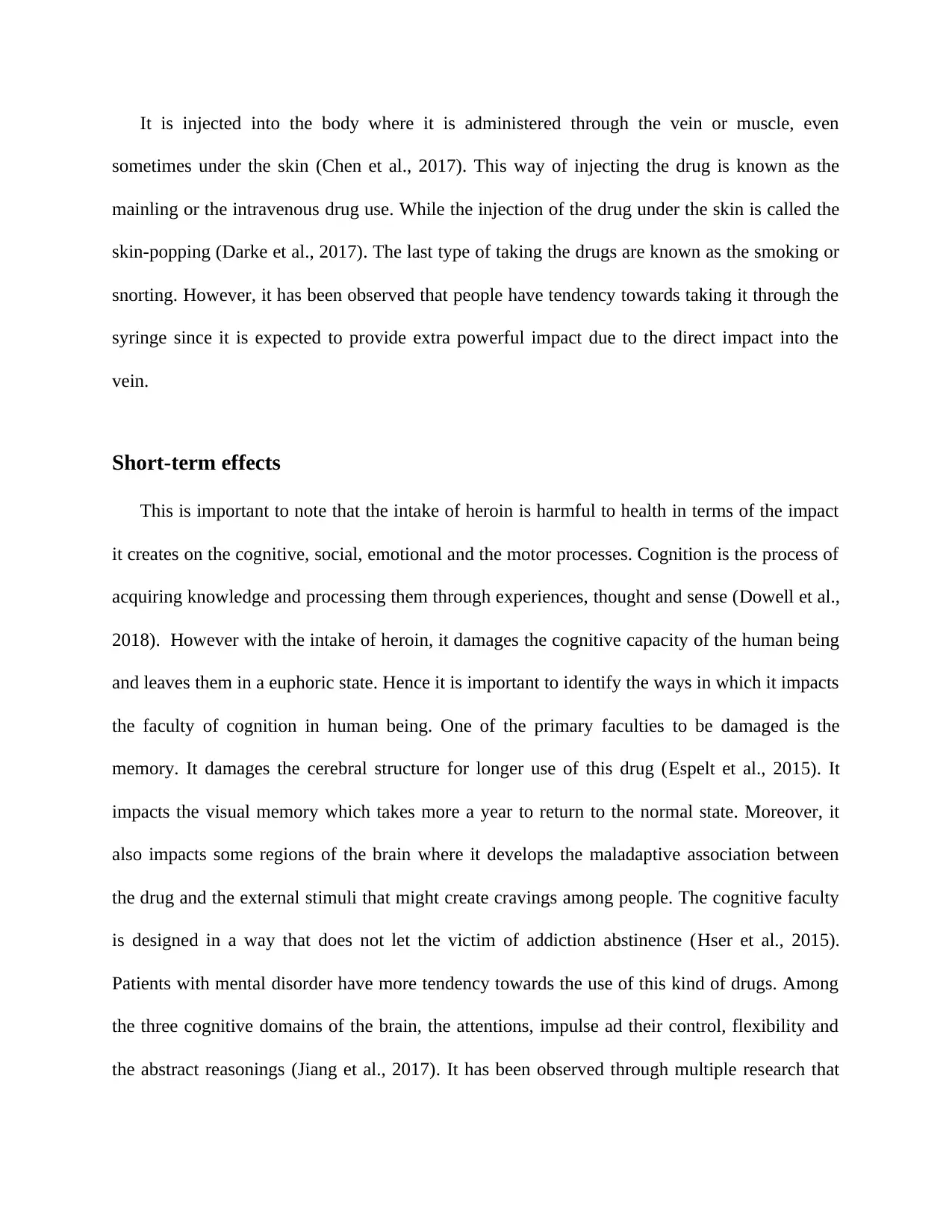
It is injected into the body where it is administered through the vein or muscle, even
sometimes under the skin (Chen et al., 2017). This way of injecting the drug is known as the
mainling or the intravenous drug use. While the injection of the drug under the skin is called the
skin-popping (Darke et al., 2017). The last type of taking the drugs are known as the smoking or
snorting. However, it has been observed that people have tendency towards taking it through the
syringe since it is expected to provide extra powerful impact due to the direct impact into the
vein.
Short-term effects
This is important to note that the intake of heroin is harmful to health in terms of the impact
it creates on the cognitive, social, emotional and the motor processes. Cognition is the process of
acquiring knowledge and processing them through experiences, thought and sense (Dowell et al.,
2018). However with the intake of heroin, it damages the cognitive capacity of the human being
and leaves them in a euphoric state. Hence it is important to identify the ways in which it impacts
the faculty of cognition in human being. One of the primary faculties to be damaged is the
memory. It damages the cerebral structure for longer use of this drug (Espelt et al., 2015). It
impacts the visual memory which takes more a year to return to the normal state. Moreover, it
also impacts some regions of the brain where it develops the maladaptive association between
the drug and the external stimuli that might create cravings among people. The cognitive faculty
is designed in a way that does not let the victim of addiction abstinence (Hser et al., 2015).
Patients with mental disorder have more tendency towards the use of this kind of drugs. Among
the three cognitive domains of the brain, the attentions, impulse ad their control, flexibility and
the abstract reasonings (Jiang et al., 2017). It has been observed through multiple research that
sometimes under the skin (Chen et al., 2017). This way of injecting the drug is known as the
mainling or the intravenous drug use. While the injection of the drug under the skin is called the
skin-popping (Darke et al., 2017). The last type of taking the drugs are known as the smoking or
snorting. However, it has been observed that people have tendency towards taking it through the
syringe since it is expected to provide extra powerful impact due to the direct impact into the
vein.
Short-term effects
This is important to note that the intake of heroin is harmful to health in terms of the impact
it creates on the cognitive, social, emotional and the motor processes. Cognition is the process of
acquiring knowledge and processing them through experiences, thought and sense (Dowell et al.,
2018). However with the intake of heroin, it damages the cognitive capacity of the human being
and leaves them in a euphoric state. Hence it is important to identify the ways in which it impacts
the faculty of cognition in human being. One of the primary faculties to be damaged is the
memory. It damages the cerebral structure for longer use of this drug (Espelt et al., 2015). It
impacts the visual memory which takes more a year to return to the normal state. Moreover, it
also impacts some regions of the brain where it develops the maladaptive association between
the drug and the external stimuli that might create cravings among people. The cognitive faculty
is designed in a way that does not let the victim of addiction abstinence (Hser et al., 2015).
Patients with mental disorder have more tendency towards the use of this kind of drugs. Among
the three cognitive domains of the brain, the attentions, impulse ad their control, flexibility and
the abstract reasonings (Jiang et al., 2017). It has been observed through multiple research that
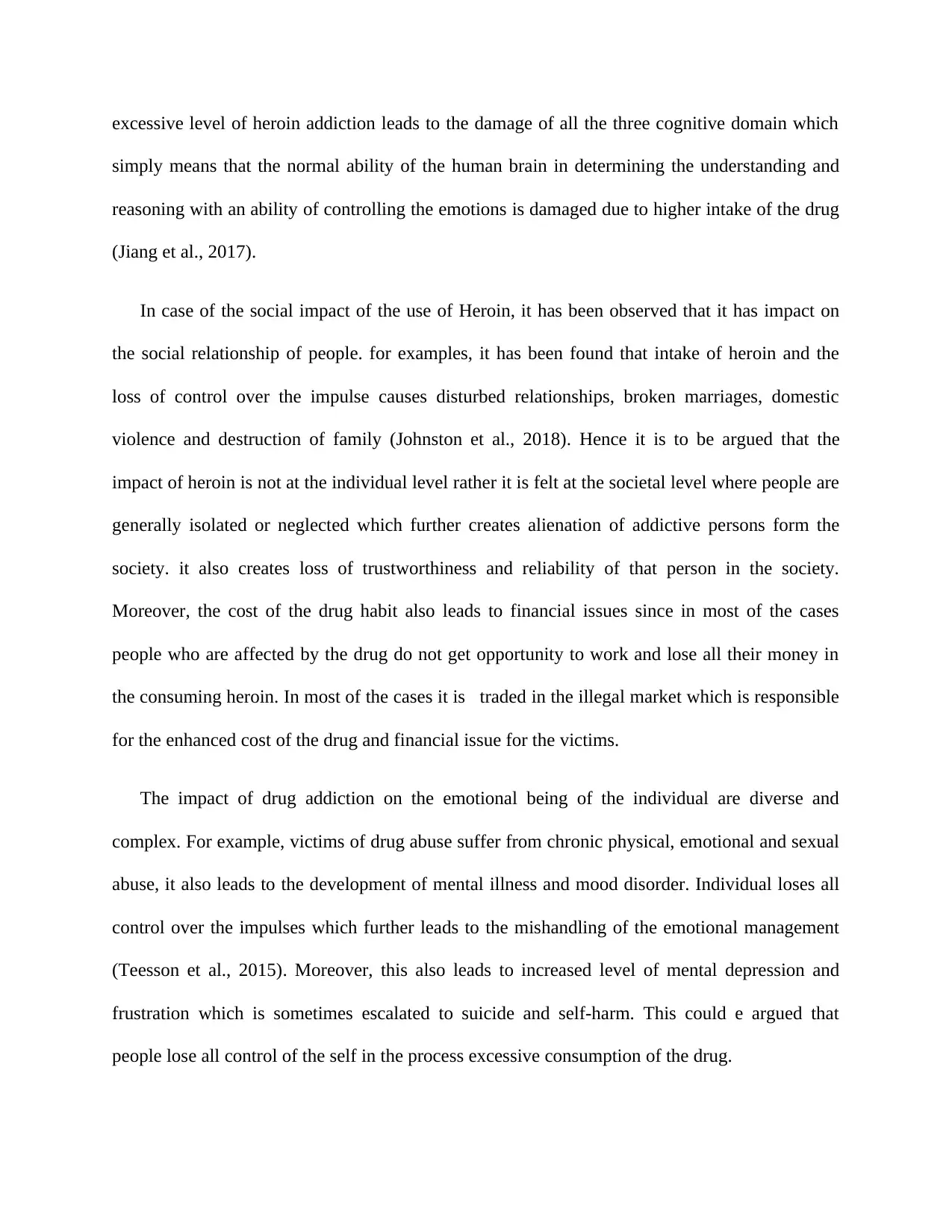
excessive level of heroin addiction leads to the damage of all the three cognitive domain which
simply means that the normal ability of the human brain in determining the understanding and
reasoning with an ability of controlling the emotions is damaged due to higher intake of the drug
(Jiang et al., 2017).
In case of the social impact of the use of Heroin, it has been observed that it has impact on
the social relationship of people. for examples, it has been found that intake of heroin and the
loss of control over the impulse causes disturbed relationships, broken marriages, domestic
violence and destruction of family (Johnston et al., 2018). Hence it is to be argued that the
impact of heroin is not at the individual level rather it is felt at the societal level where people are
generally isolated or neglected which further creates alienation of addictive persons form the
society. it also creates loss of trustworthiness and reliability of that person in the society.
Moreover, the cost of the drug habit also leads to financial issues since in most of the cases
people who are affected by the drug do not get opportunity to work and lose all their money in
the consuming heroin. In most of the cases it is traded in the illegal market which is responsible
for the enhanced cost of the drug and financial issue for the victims.
The impact of drug addiction on the emotional being of the individual are diverse and
complex. For example, victims of drug abuse suffer from chronic physical, emotional and sexual
abuse, it also leads to the development of mental illness and mood disorder. Individual loses all
control over the impulses which further leads to the mishandling of the emotional management
(Teesson et al., 2015). Moreover, this also leads to increased level of mental depression and
frustration which is sometimes escalated to suicide and self-harm. This could e argued that
people lose all control of the self in the process excessive consumption of the drug.
simply means that the normal ability of the human brain in determining the understanding and
reasoning with an ability of controlling the emotions is damaged due to higher intake of the drug
(Jiang et al., 2017).
In case of the social impact of the use of Heroin, it has been observed that it has impact on
the social relationship of people. for examples, it has been found that intake of heroin and the
loss of control over the impulse causes disturbed relationships, broken marriages, domestic
violence and destruction of family (Johnston et al., 2018). Hence it is to be argued that the
impact of heroin is not at the individual level rather it is felt at the societal level where people are
generally isolated or neglected which further creates alienation of addictive persons form the
society. it also creates loss of trustworthiness and reliability of that person in the society.
Moreover, the cost of the drug habit also leads to financial issues since in most of the cases
people who are affected by the drug do not get opportunity to work and lose all their money in
the consuming heroin. In most of the cases it is traded in the illegal market which is responsible
for the enhanced cost of the drug and financial issue for the victims.
The impact of drug addiction on the emotional being of the individual are diverse and
complex. For example, victims of drug abuse suffer from chronic physical, emotional and sexual
abuse, it also leads to the development of mental illness and mood disorder. Individual loses all
control over the impulses which further leads to the mishandling of the emotional management
(Teesson et al., 2015). Moreover, this also leads to increased level of mental depression and
frustration which is sometimes escalated to suicide and self-harm. This could e argued that
people lose all control of the self in the process excessive consumption of the drug.
Secure Best Marks with AI Grader
Need help grading? Try our AI Grader for instant feedback on your assignments.
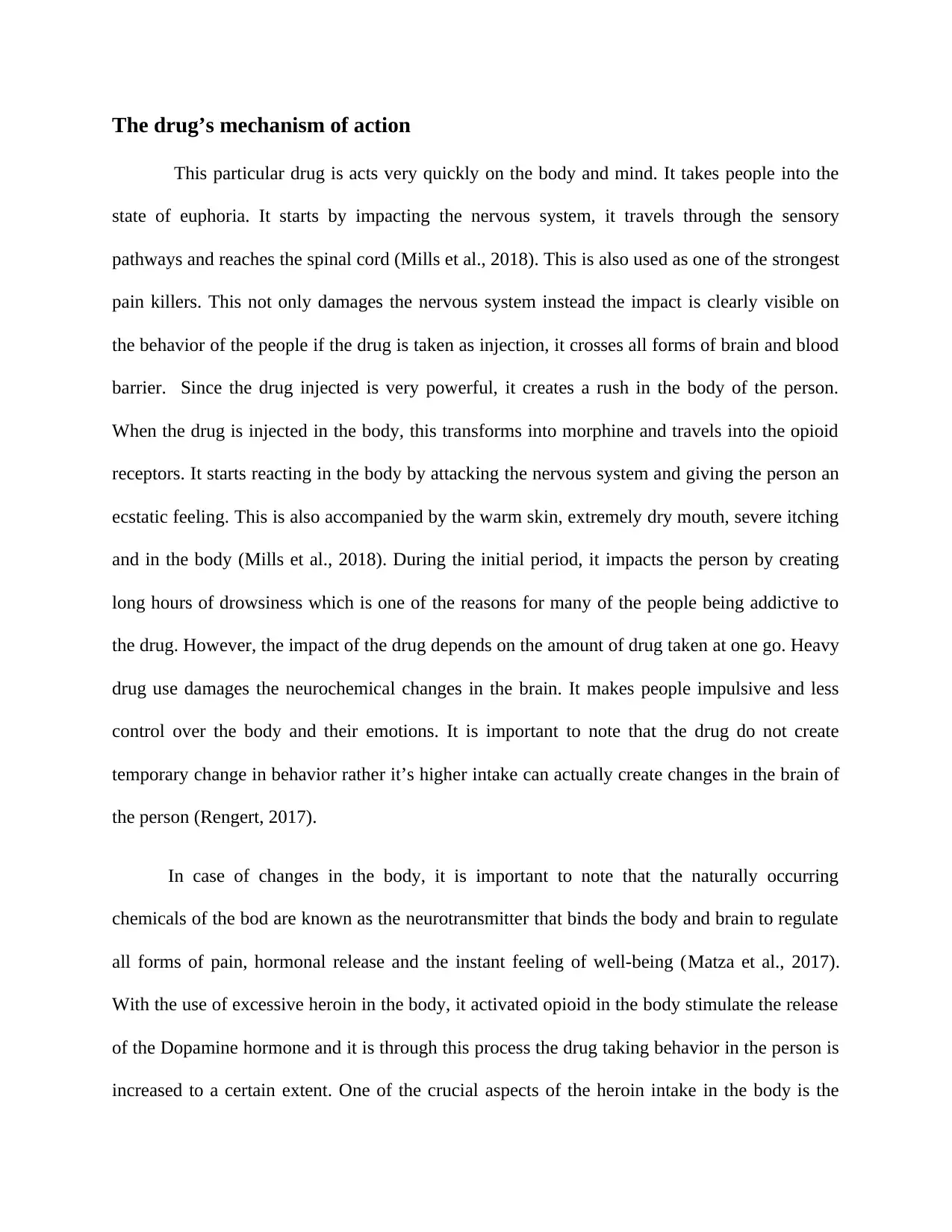
The drug’s mechanism of action
This particular drug is acts very quickly on the body and mind. It takes people into the
state of euphoria. It starts by impacting the nervous system, it travels through the sensory
pathways and reaches the spinal cord (Mills et al., 2018). This is also used as one of the strongest
pain killers. This not only damages the nervous system instead the impact is clearly visible on
the behavior of the people if the drug is taken as injection, it crosses all forms of brain and blood
barrier. Since the drug injected is very powerful, it creates a rush in the body of the person.
When the drug is injected in the body, this transforms into morphine and travels into the opioid
receptors. It starts reacting in the body by attacking the nervous system and giving the person an
ecstatic feeling. This is also accompanied by the warm skin, extremely dry mouth, severe itching
and in the body (Mills et al., 2018). During the initial period, it impacts the person by creating
long hours of drowsiness which is one of the reasons for many of the people being addictive to
the drug. However, the impact of the drug depends on the amount of drug taken at one go. Heavy
drug use damages the neurochemical changes in the brain. It makes people impulsive and less
control over the body and their emotions. It is important to note that the drug do not create
temporary change in behavior rather it’s higher intake can actually create changes in the brain of
the person (Rengert, 2017).
In case of changes in the body, it is important to note that the naturally occurring
chemicals of the bod are known as the neurotransmitter that binds the body and brain to regulate
all forms of pain, hormonal release and the instant feeling of well-being (Matza et al., 2017).
With the use of excessive heroin in the body, it activated opioid in the body stimulate the release
of the Dopamine hormone and it is through this process the drug taking behavior in the person is
increased to a certain extent. One of the crucial aspects of the heroin intake in the body is the
This particular drug is acts very quickly on the body and mind. It takes people into the
state of euphoria. It starts by impacting the nervous system, it travels through the sensory
pathways and reaches the spinal cord (Mills et al., 2018). This is also used as one of the strongest
pain killers. This not only damages the nervous system instead the impact is clearly visible on
the behavior of the people if the drug is taken as injection, it crosses all forms of brain and blood
barrier. Since the drug injected is very powerful, it creates a rush in the body of the person.
When the drug is injected in the body, this transforms into morphine and travels into the opioid
receptors. It starts reacting in the body by attacking the nervous system and giving the person an
ecstatic feeling. This is also accompanied by the warm skin, extremely dry mouth, severe itching
and in the body (Mills et al., 2018). During the initial period, it impacts the person by creating
long hours of drowsiness which is one of the reasons for many of the people being addictive to
the drug. However, the impact of the drug depends on the amount of drug taken at one go. Heavy
drug use damages the neurochemical changes in the brain. It makes people impulsive and less
control over the body and their emotions. It is important to note that the drug do not create
temporary change in behavior rather it’s higher intake can actually create changes in the brain of
the person (Rengert, 2017).
In case of changes in the body, it is important to note that the naturally occurring
chemicals of the bod are known as the neurotransmitter that binds the body and brain to regulate
all forms of pain, hormonal release and the instant feeling of well-being (Matza et al., 2017).
With the use of excessive heroin in the body, it activated opioid in the body stimulate the release
of the Dopamine hormone and it is through this process the drug taking behavior in the person is
increased to a certain extent. One of the crucial aspects of the heroin intake in the body is the
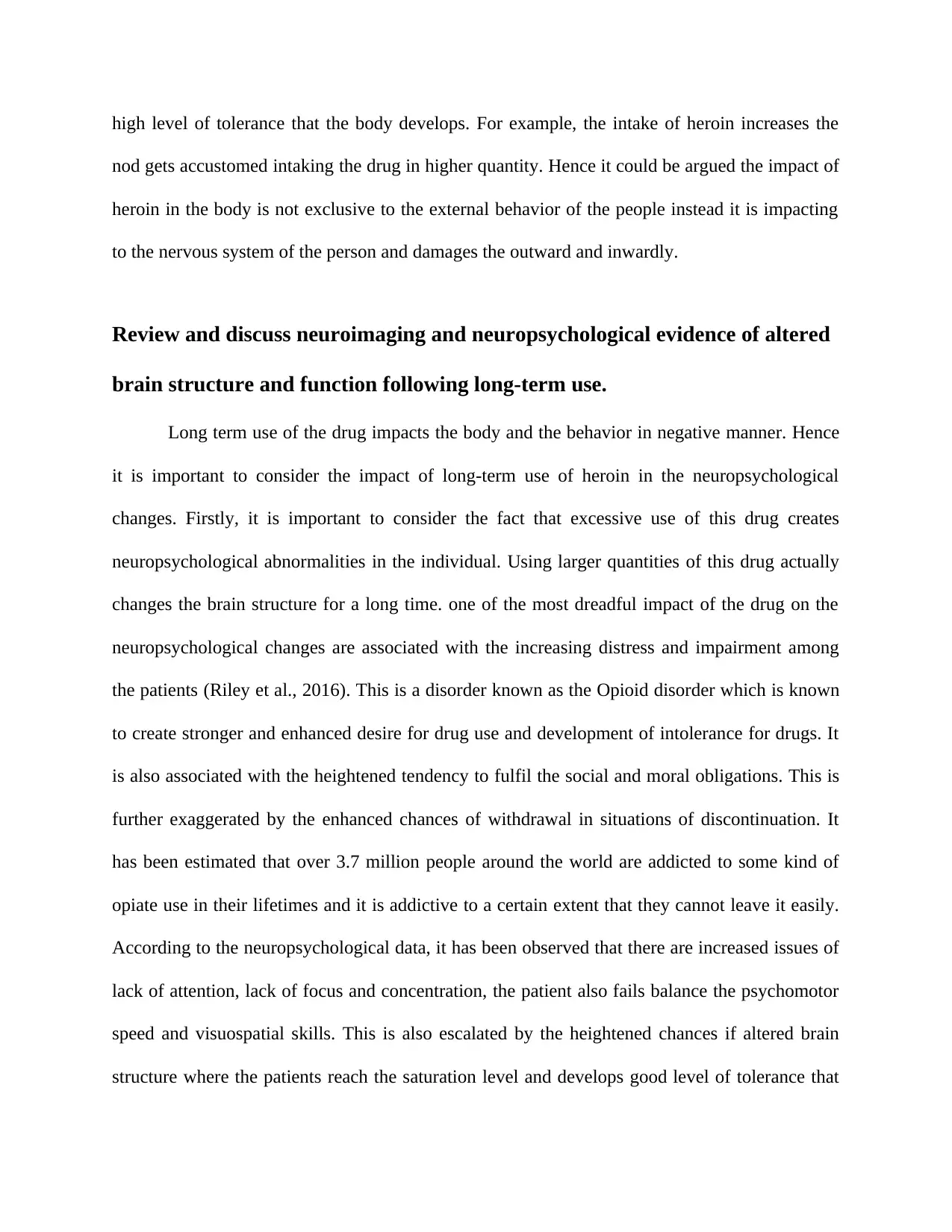
high level of tolerance that the body develops. For example, the intake of heroin increases the
nod gets accustomed intaking the drug in higher quantity. Hence it could be argued the impact of
heroin in the body is not exclusive to the external behavior of the people instead it is impacting
to the nervous system of the person and damages the outward and inwardly.
Review and discuss neuroimaging and neuropsychological evidence of altered
brain structure and function following long-term use.
Long term use of the drug impacts the body and the behavior in negative manner. Hence
it is important to consider the impact of long-term use of heroin in the neuropsychological
changes. Firstly, it is important to consider the fact that excessive use of this drug creates
neuropsychological abnormalities in the individual. Using larger quantities of this drug actually
changes the brain structure for a long time. one of the most dreadful impact of the drug on the
neuropsychological changes are associated with the increasing distress and impairment among
the patients (Riley et al., 2016). This is a disorder known as the Opioid disorder which is known
to create stronger and enhanced desire for drug use and development of intolerance for drugs. It
is also associated with the heightened tendency to fulfil the social and moral obligations. This is
further exaggerated by the enhanced chances of withdrawal in situations of discontinuation. It
has been estimated that over 3.7 million people around the world are addicted to some kind of
opiate use in their lifetimes and it is addictive to a certain extent that they cannot leave it easily.
According to the neuropsychological data, it has been observed that there are increased issues of
lack of attention, lack of focus and concentration, the patient also fails balance the psychomotor
speed and visuospatial skills. This is also escalated by the heightened chances if altered brain
structure where the patients reach the saturation level and develops good level of tolerance that
nod gets accustomed intaking the drug in higher quantity. Hence it could be argued the impact of
heroin in the body is not exclusive to the external behavior of the people instead it is impacting
to the nervous system of the person and damages the outward and inwardly.
Review and discuss neuroimaging and neuropsychological evidence of altered
brain structure and function following long-term use.
Long term use of the drug impacts the body and the behavior in negative manner. Hence
it is important to consider the impact of long-term use of heroin in the neuropsychological
changes. Firstly, it is important to consider the fact that excessive use of this drug creates
neuropsychological abnormalities in the individual. Using larger quantities of this drug actually
changes the brain structure for a long time. one of the most dreadful impact of the drug on the
neuropsychological changes are associated with the increasing distress and impairment among
the patients (Riley et al., 2016). This is a disorder known as the Opioid disorder which is known
to create stronger and enhanced desire for drug use and development of intolerance for drugs. It
is also associated with the heightened tendency to fulfil the social and moral obligations. This is
further exaggerated by the enhanced chances of withdrawal in situations of discontinuation. It
has been estimated that over 3.7 million people around the world are addicted to some kind of
opiate use in their lifetimes and it is addictive to a certain extent that they cannot leave it easily.
According to the neuropsychological data, it has been observed that there are increased issues of
lack of attention, lack of focus and concentration, the patient also fails balance the psychomotor
speed and visuospatial skills. This is also escalated by the heightened chances if altered brain
structure where the patients reach the saturation level and develops good level of tolerance that
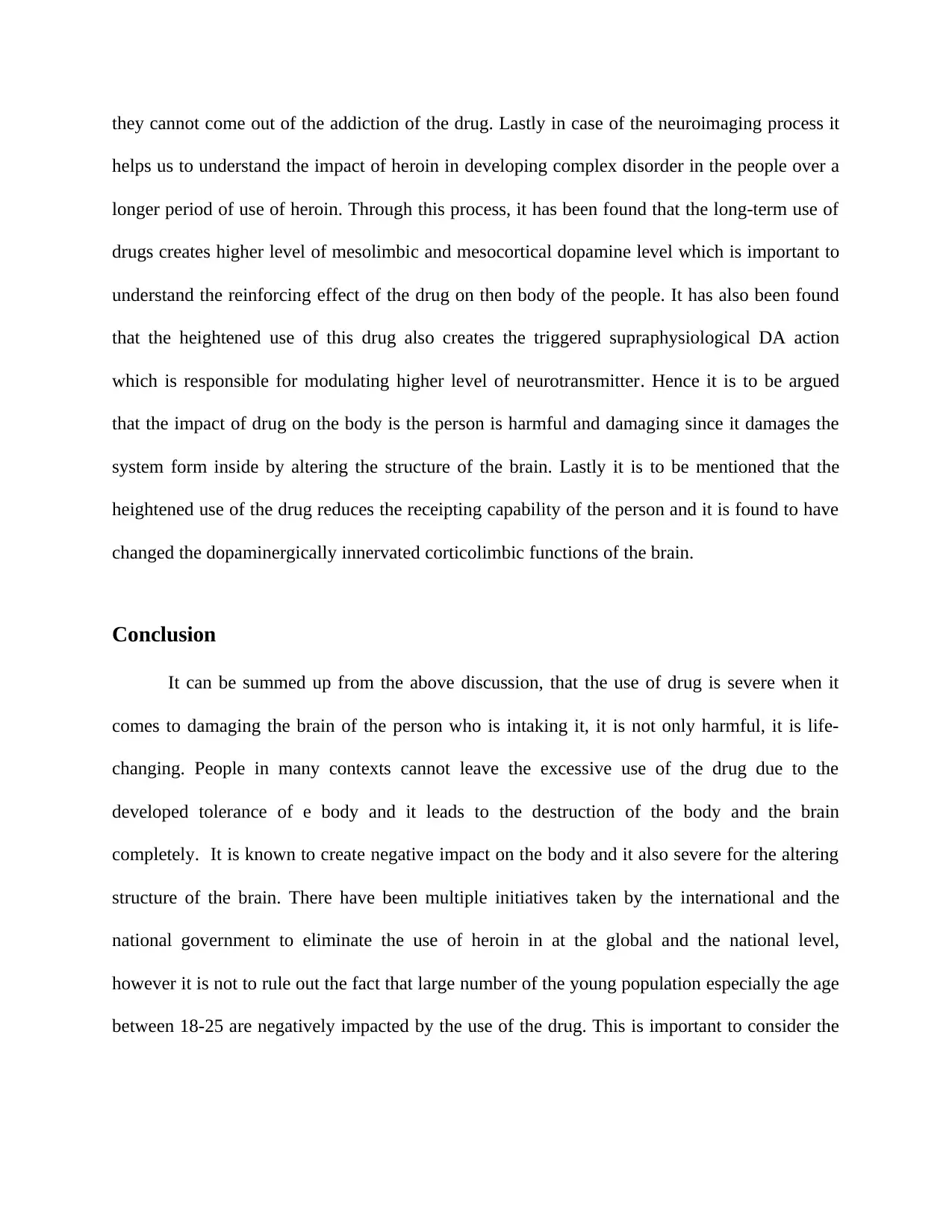
they cannot come out of the addiction of the drug. Lastly in case of the neuroimaging process it
helps us to understand the impact of heroin in developing complex disorder in the people over a
longer period of use of heroin. Through this process, it has been found that the long-term use of
drugs creates higher level of mesolimbic and mesocortical dopamine level which is important to
understand the reinforcing effect of the drug on then body of the people. It has also been found
that the heightened use of this drug also creates the triggered supraphysiological DA action
which is responsible for modulating higher level of neurotransmitter. Hence it is to be argued
that the impact of drug on the body is the person is harmful and damaging since it damages the
system form inside by altering the structure of the brain. Lastly it is to be mentioned that the
heightened use of the drug reduces the receipting capability of the person and it is found to have
changed the dopaminergically innervated corticolimbic functions of the brain.
Conclusion
It can be summed up from the above discussion, that the use of drug is severe when it
comes to damaging the brain of the person who is intaking it, it is not only harmful, it is life-
changing. People in many contexts cannot leave the excessive use of the drug due to the
developed tolerance of e body and it leads to the destruction of the body and the brain
completely. It is known to create negative impact on the body and it also severe for the altering
structure of the brain. There have been multiple initiatives taken by the international and the
national government to eliminate the use of heroin in at the global and the national level,
however it is not to rule out the fact that large number of the young population especially the age
between 18-25 are negatively impacted by the use of the drug. This is important to consider the
helps us to understand the impact of heroin in developing complex disorder in the people over a
longer period of use of heroin. Through this process, it has been found that the long-term use of
drugs creates higher level of mesolimbic and mesocortical dopamine level which is important to
understand the reinforcing effect of the drug on then body of the people. It has also been found
that the heightened use of this drug also creates the triggered supraphysiological DA action
which is responsible for modulating higher level of neurotransmitter. Hence it is to be argued
that the impact of drug on the body is the person is harmful and damaging since it damages the
system form inside by altering the structure of the brain. Lastly it is to be mentioned that the
heightened use of the drug reduces the receipting capability of the person and it is found to have
changed the dopaminergically innervated corticolimbic functions of the brain.
Conclusion
It can be summed up from the above discussion, that the use of drug is severe when it
comes to damaging the brain of the person who is intaking it, it is not only harmful, it is life-
changing. People in many contexts cannot leave the excessive use of the drug due to the
developed tolerance of e body and it leads to the destruction of the body and the brain
completely. It is known to create negative impact on the body and it also severe for the altering
structure of the brain. There have been multiple initiatives taken by the international and the
national government to eliminate the use of heroin in at the global and the national level,
however it is not to rule out the fact that large number of the young population especially the age
between 18-25 are negatively impacted by the use of the drug. This is important to consider the
Paraphrase This Document
Need a fresh take? Get an instant paraphrase of this document with our AI Paraphraser

fact that the use of heroin creates distress, frustration, changes in behavior and slow death for
people with stronger addiction to it.
people with stronger addiction to it.
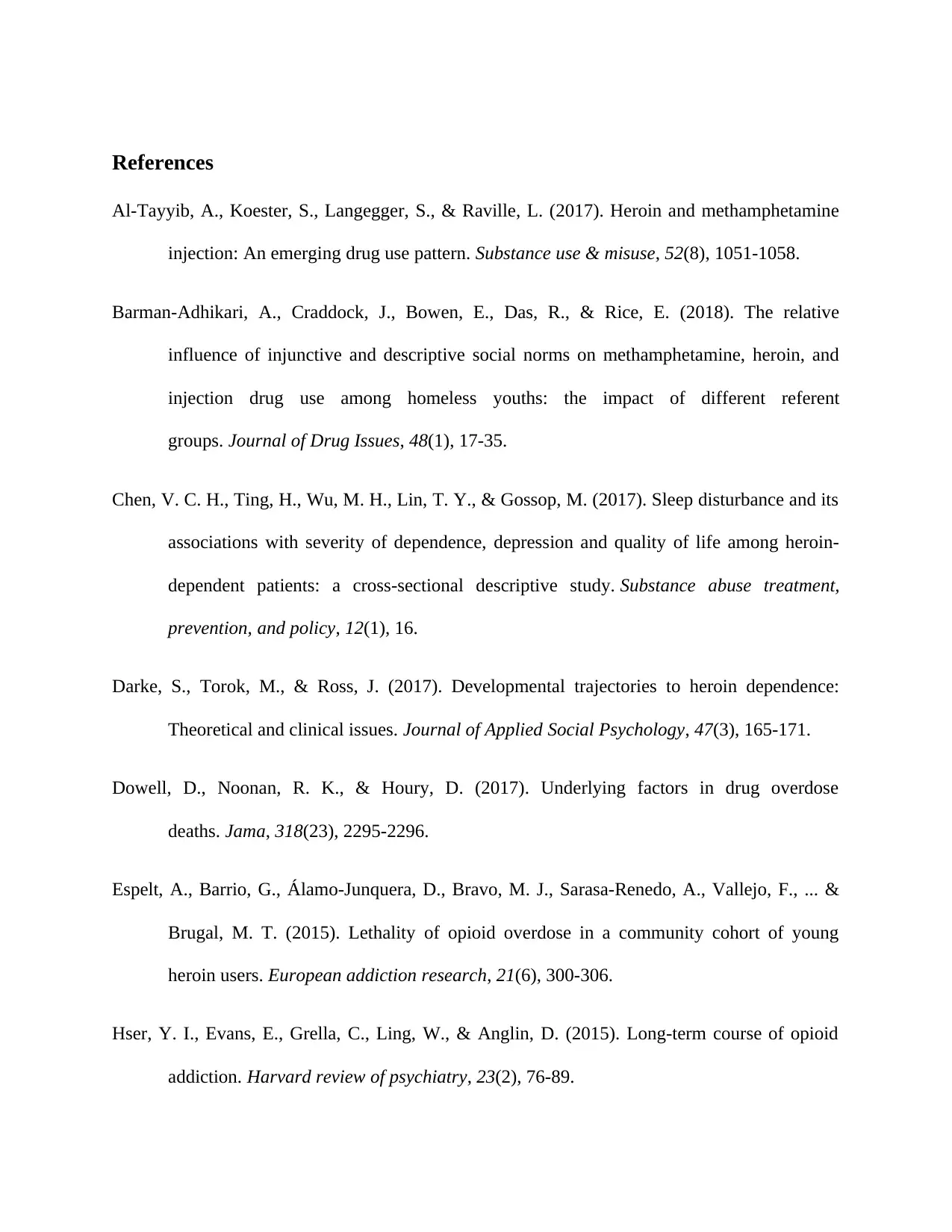
References
Al-Tayyib, A., Koester, S., Langegger, S., & Raville, L. (2017). Heroin and methamphetamine
injection: An emerging drug use pattern. Substance use & misuse, 52(8), 1051-1058.
Barman-Adhikari, A., Craddock, J., Bowen, E., Das, R., & Rice, E. (2018). The relative
influence of injunctive and descriptive social norms on methamphetamine, heroin, and
injection drug use among homeless youths: the impact of different referent
groups. Journal of Drug Issues, 48(1), 17-35.
Chen, V. C. H., Ting, H., Wu, M. H., Lin, T. Y., & Gossop, M. (2017). Sleep disturbance and its
associations with severity of dependence, depression and quality of life among heroin-
dependent patients: a cross-sectional descriptive study. Substance abuse treatment,
prevention, and policy, 12(1), 16.
Darke, S., Torok, M., & Ross, J. (2017). Developmental trajectories to heroin dependence:
Theoretical and clinical issues. Journal of Applied Social Psychology, 47(3), 165-171.
Dowell, D., Noonan, R. K., & Houry, D. (2017). Underlying factors in drug overdose
deaths. Jama, 318(23), 2295-2296.
Espelt, A., Barrio, G., Álamo-Junquera, D., Bravo, M. J., Sarasa-Renedo, A., Vallejo, F., ... &
Brugal, M. T. (2015). Lethality of opioid overdose in a community cohort of young
heroin users. European addiction research, 21(6), 300-306.
Hser, Y. I., Evans, E., Grella, C., Ling, W., & Anglin, D. (2015). Long-term course of opioid
addiction. Harvard review of psychiatry, 23(2), 76-89.
Al-Tayyib, A., Koester, S., Langegger, S., & Raville, L. (2017). Heroin and methamphetamine
injection: An emerging drug use pattern. Substance use & misuse, 52(8), 1051-1058.
Barman-Adhikari, A., Craddock, J., Bowen, E., Das, R., & Rice, E. (2018). The relative
influence of injunctive and descriptive social norms on methamphetamine, heroin, and
injection drug use among homeless youths: the impact of different referent
groups. Journal of Drug Issues, 48(1), 17-35.
Chen, V. C. H., Ting, H., Wu, M. H., Lin, T. Y., & Gossop, M. (2017). Sleep disturbance and its
associations with severity of dependence, depression and quality of life among heroin-
dependent patients: a cross-sectional descriptive study. Substance abuse treatment,
prevention, and policy, 12(1), 16.
Darke, S., Torok, M., & Ross, J. (2017). Developmental trajectories to heroin dependence:
Theoretical and clinical issues. Journal of Applied Social Psychology, 47(3), 165-171.
Dowell, D., Noonan, R. K., & Houry, D. (2017). Underlying factors in drug overdose
deaths. Jama, 318(23), 2295-2296.
Espelt, A., Barrio, G., Álamo-Junquera, D., Bravo, M. J., Sarasa-Renedo, A., Vallejo, F., ... &
Brugal, M. T. (2015). Lethality of opioid overdose in a community cohort of young
heroin users. European addiction research, 21(6), 300-306.
Hser, Y. I., Evans, E., Grella, C., Ling, W., & Anglin, D. (2015). Long-term course of opioid
addiction. Harvard review of psychiatry, 23(2), 76-89.
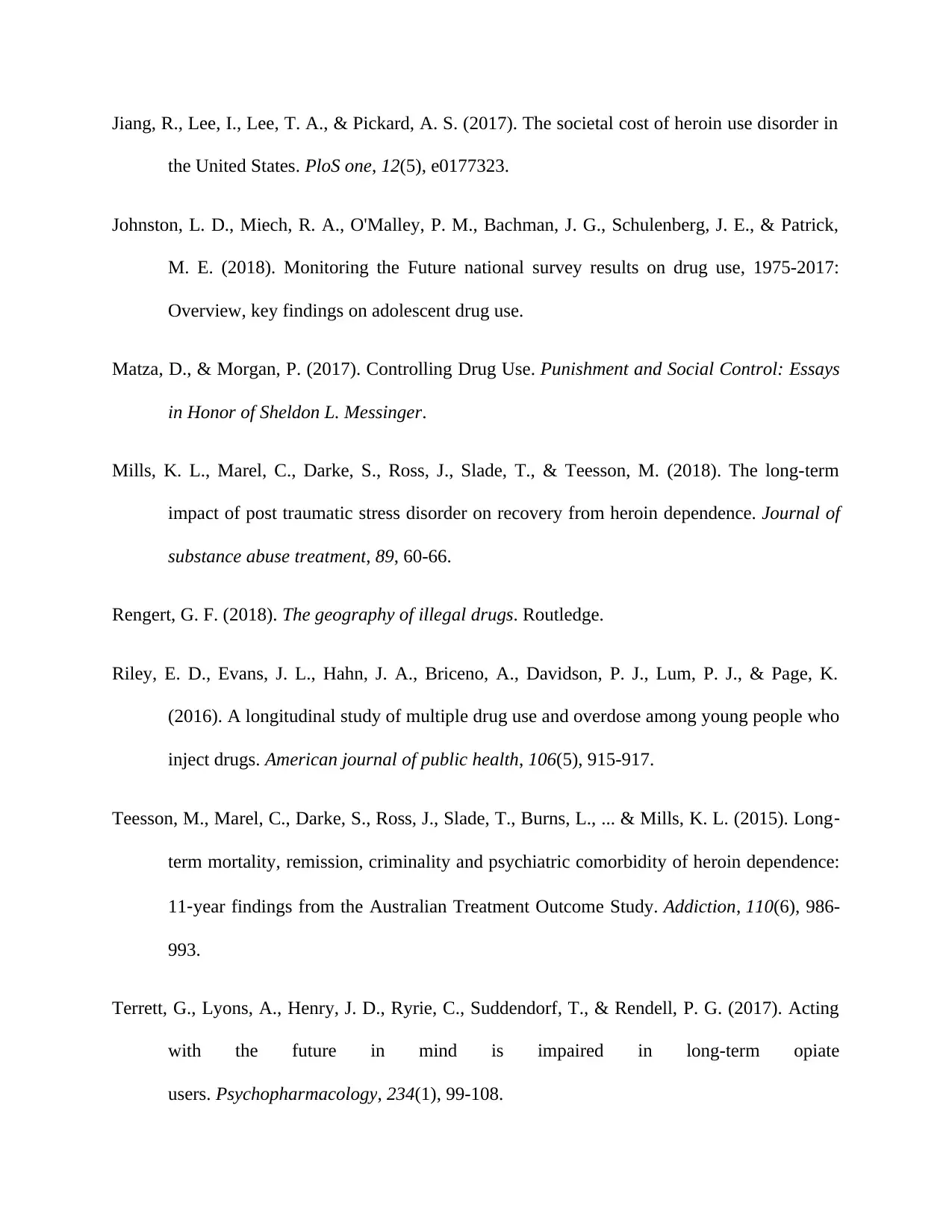
Jiang, R., Lee, I., Lee, T. A., & Pickard, A. S. (2017). The societal cost of heroin use disorder in
the United States. PloS one, 12(5), e0177323.
Johnston, L. D., Miech, R. A., O'Malley, P. M., Bachman, J. G., Schulenberg, J. E., & Patrick,
M. E. (2018). Monitoring the Future national survey results on drug use, 1975-2017:
Overview, key findings on adolescent drug use.
Matza, D., & Morgan, P. (2017). Controlling Drug Use. Punishment and Social Control: Essays
in Honor of Sheldon L. Messinger.
Mills, K. L., Marel, C., Darke, S., Ross, J., Slade, T., & Teesson, M. (2018). The long-term
impact of post traumatic stress disorder on recovery from heroin dependence. Journal of
substance abuse treatment, 89, 60-66.
Rengert, G. F. (2018). The geography of illegal drugs. Routledge.
Riley, E. D., Evans, J. L., Hahn, J. A., Briceno, A., Davidson, P. J., Lum, P. J., & Page, K.
(2016). A longitudinal study of multiple drug use and overdose among young people who
inject drugs. American journal of public health, 106(5), 915-917.
Teesson, M., Marel, C., Darke, S., Ross, J., Slade, T., Burns, L., ... & Mills, K. L. (2015). Long‐
term mortality, remission, criminality and psychiatric comorbidity of heroin dependence:
11‐year findings from the Australian Treatment Outcome Study. Addiction, 110(6), 986-
993.
Terrett, G., Lyons, A., Henry, J. D., Ryrie, C., Suddendorf, T., & Rendell, P. G. (2017). Acting
with the future in mind is impaired in long-term opiate
users. Psychopharmacology, 234(1), 99-108.
the United States. PloS one, 12(5), e0177323.
Johnston, L. D., Miech, R. A., O'Malley, P. M., Bachman, J. G., Schulenberg, J. E., & Patrick,
M. E. (2018). Monitoring the Future national survey results on drug use, 1975-2017:
Overview, key findings on adolescent drug use.
Matza, D., & Morgan, P. (2017). Controlling Drug Use. Punishment and Social Control: Essays
in Honor of Sheldon L. Messinger.
Mills, K. L., Marel, C., Darke, S., Ross, J., Slade, T., & Teesson, M. (2018). The long-term
impact of post traumatic stress disorder on recovery from heroin dependence. Journal of
substance abuse treatment, 89, 60-66.
Rengert, G. F. (2018). The geography of illegal drugs. Routledge.
Riley, E. D., Evans, J. L., Hahn, J. A., Briceno, A., Davidson, P. J., Lum, P. J., & Page, K.
(2016). A longitudinal study of multiple drug use and overdose among young people who
inject drugs. American journal of public health, 106(5), 915-917.
Teesson, M., Marel, C., Darke, S., Ross, J., Slade, T., Burns, L., ... & Mills, K. L. (2015). Long‐
term mortality, remission, criminality and psychiatric comorbidity of heroin dependence:
11‐year findings from the Australian Treatment Outcome Study. Addiction, 110(6), 986-
993.
Terrett, G., Lyons, A., Henry, J. D., Ryrie, C., Suddendorf, T., & Rendell, P. G. (2017). Acting
with the future in mind is impaired in long-term opiate
users. Psychopharmacology, 234(1), 99-108.
1 out of 10
Related Documents
Your All-in-One AI-Powered Toolkit for Academic Success.
+13062052269
info@desklib.com
Available 24*7 on WhatsApp / Email
![[object Object]](/_next/static/media/star-bottom.7253800d.svg)
Unlock your academic potential
© 2024 | Zucol Services PVT LTD | All rights reserved.





